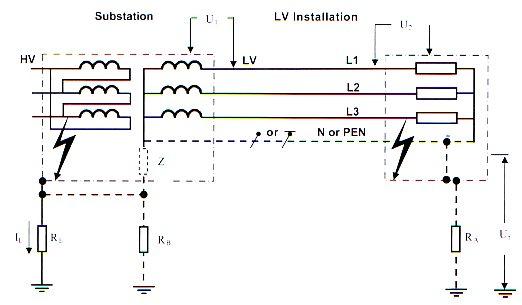- Joined
- 27 Jan 2008
- Messages
- 27,659
- Reaction score
- 3,345
- Location
- Llanfair Caereinion, Nr Welshpool
- Country

A friend of mine had a shed at the bottom of his garden which he used as a radio shack. The earth for the radio was four rods one in each corner of garden and buried copper tape between i.e. very good. The electrician who wired the shed had not used the steel wire armour but run a 4mm wire under it to take earth from house (PME) to shed. And had bonded items including the earth bar for the radios.While on the topic of earthing,
PME systems. Protective Multiple Earths, On overhead systems there are on some poles a wire down the pole from the neutral to an earth rod. ( some of these do appear to need maintainance where dog pee and other things have severed the connection at ground level ).
As the network distributed neutral is also the source of the "earth" in the domestic property it would seem logical that an earth rod at a house and connected to the MEB would be doing exactly the same job as the (possibly defunct) earthing of the neutral at the distribution pole.
So why is it considered not a good idea to have an earth rod at a property that has a PME supply to it. ?
Workers digging the road hit the cable. The insulation on the earth wire started to melt. I was called and all power switched off. On arriving the 4mm cable was a row of copper bits on the floor.
Removed lid from consumer unit and measured incoming voltage which varied from 10 to 390 volts.
Phoned supplier who told me it is impossible to lose a neutral/earth on a PME supply but workers arrived soon after and compensation was paid to people in road who's equipment had been damaged.
So on a PME system if you are going to install an earth rod make sure the cable connecting it is quite hefty and can take the current from whole system.
Of course with PME it is not an earth rod it is a "extraneous-conductive-part" in the same way as a cast iron waste pipe in coming water main or gas supply. Where homes have metal water and gas supply they do really have extra earths and since all houses will be the same the current down these routes will be shared between all the houses. The problem arises where one house is group is odd one out.
And there are not that many radio hams in the street so he was the odd one out.
As to High voltage and Low voltage getting joined together I know of no time when this has happened. I hope that never changes. However I still think steps should be taken in case. This is now covered in 17th Edition see 44.1


